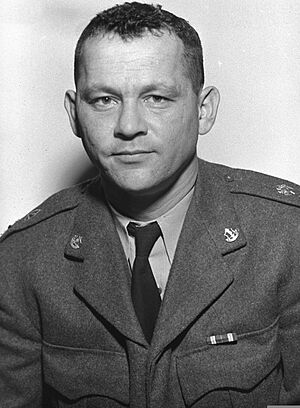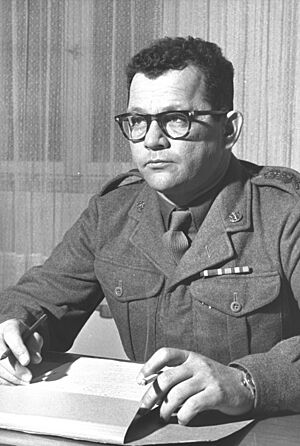Haim Laskov facts for kids
Quick facts for kids
Haim Laskov
|
|
|---|---|

Haim Laskov in 1952
|
|
| Born | 1919 Barysaw, Byelorussian Soviet Socialist Republic |
| Died | December 8, 1982 (age 62-63) Israel |
| Allegiance | |
| Service/ |
|
| Years of service | 1932–1965 |
| Rank | |
| Battles/wars | World War II 1948 Arab–Israeli War Suez Crisis |
| Signature | |
Haim Laskov (Hebrew: חיים לסקוב; 1919 – 8 December 1982) was an important Israeli public figure. He was the fifth Chief of Staff of the Israel Defense Forces (IDF). This is the highest military leader position in Israel.
Contents
About Haim Laskov
Haim Laskov was born in Barysaw, which is now in Belarus. In 1925, when he was young, his family moved to Palestine. This is what Israel was called before it became a country. They settled in the city of Haifa.
As a teenager, Laskov joined the Haganah. This was a Jewish defense group in Palestine. He worked in different parts of the Haganah. He even served in special units led by Orde Wingate. Laskov also worked as a personal helper for Yaakov Dori. Dori later became the first Chief of Staff of the IDF.
In 1940, Laskov joined the British Army. He wanted to fight in World War II. He became a commander in the Jewish Brigade. This was a special unit of Jewish soldiers. They fought in Italy. Laskov reached the rank of major. After the war, he stayed in Europe. He helped Jewish refugees move to Palestine. This was part of a secret effort called Aliyah Bet. He also helped bring to justice people who had committed terrible crimes against Jews during the war. When he returned to Palestine, he rejoined the Haganah. He also worked as the head of security for the electric company.
Haim Laskov was married to Shulamit.
Laskov's Military Journey
When the 1948 Arab–Israeli War started in 1948, Laskov had a big job. He was in charge of training new soldiers. He set up the first course for officers. He also formed a brigade of these new officers. This brigade fought in battles at Latrun.
Later, in May 1948, he led Israel's first armored battalion. This unit fought alongside the 7th Brigade. Laskov then commanded the entire 7th Brigade. They fought in many battles to control the Galilee area. After the war, he went back to training new soldiers. By then, he had the rank of major general.
In 1951, Laskov became the commander of the Israeli Air Force. This was interesting because he had never been a pilot! During his time, the air force got its first jet fighter, the Gloster Meteor. After his time in the air force ended in 1953, Laskov left the army. He went to the United Kingdom to study. He learned about philosophy, economics, and political science. He also got more military training there.
In 1955, he came back to Israel. He became the Deputy Chief of the General Staff. He was also a Senior Staff Officer. Later, he became the Commander of the Armored Corps. During the 1956 Sinai Campaign, he led the 77th Division. This division fought in the Rafah area. When the Chief of the Southern Command passed away, Laskov took his place. He then oversaw the Israeli troops leaving the Sinai Peninsula.
Chief of General Staff (1958–1961)
In 1958, Haim Laskov became the Chief of General Staff. He took over from Moshe Dayan. This happened when Egypt and Syria joined together. They formed the United Arab Republic. This new union made Israel worried about its safety.
Just two months later, in March 1958, Israel and Syria had heavy fighting. This happened near the Sea of Galilee. The fighting lasted for two days until a ceasefire was agreed upon.
On April 24, Laskov led a huge military parade in Jerusalem. This parade celebrated Israel's tenth birthday. Jordan had warned that such a parade would be seen as an aggressive act. During the parade, Laskov showed off Israel's newest military equipment. This included weapons captured from Egypt and Syria.
In November, Syria started attacking the Galilee again. This happened while Israeli workers were draining Lake Huleh. They were trying to get more land for farming. Laskov ordered the IDF to return fire.
The "Night of the Ducks"
One famous event during Laskov's time was a surprise training exercise. It happened on April 1, 1959. The exercise was to test how fast reserve soldiers could be called up. It was called the "Night of the Ducks". This was because one of the secret codes on the radio was "Water Fowl." This event caused a lot of worry across the country. It also made the armies of nearby Arab countries very alert. An investigation found two generals responsible for the confusion. They later resigned from their positions.
Tensions and Legacy
Tensions between Israel and Syria continued. In January 1960, Israel attacked a Syrian village called Tawfik. Israel said the Syrian army had used it to attack Israeli villages. Three Israeli soldiers died in this operation. This led to the Rotem Crisis. During this crisis, Egypt moved its army to Israel's southern border. This caught Israel by surprise. On March 9, Egyptian forces started to leave. Laskov later said this crisis was the most dramatic event of his time as Chief of Staff.
Laskov left his position as Chief of General Staff in 1961. His time was mostly peaceful, except for the clashes with Syria. During his leadership, he focused on making the IDF stronger. Israel got its first submarine and new Super Mystère jets. Just before he left, Prime Minister David Ben-Gurion announced something important. He said Israel had built a nuclear reactor near Dimona. He stated it was for peaceful purposes.
Laskov also created Israel's National Defense College. This school helps IDF generals learn more about military strategy.
Laskov's Civilian Work
In 1961, Laskov became the director general of the Ports Authority. During his time, the port of Ashdod was built. This is now a very important port in Israel. He also kept writing military training guides. He wrote many articles for military magazines.
In 1972, Laskov became Israel's first Soldier's Ombudsman. This job meant he helped soldiers with their problems. He held this job for ten years until he passed away. After the Yom Kippur War in 1973, he joined the Agranat Commission. This group looked into the problems that led to the war.
See also
- List of Israel's Chiefs of the General Staff


